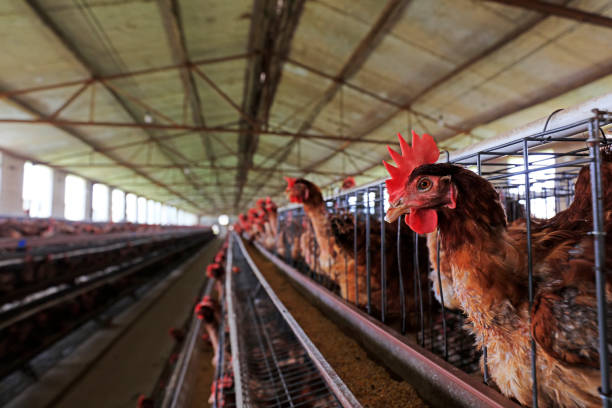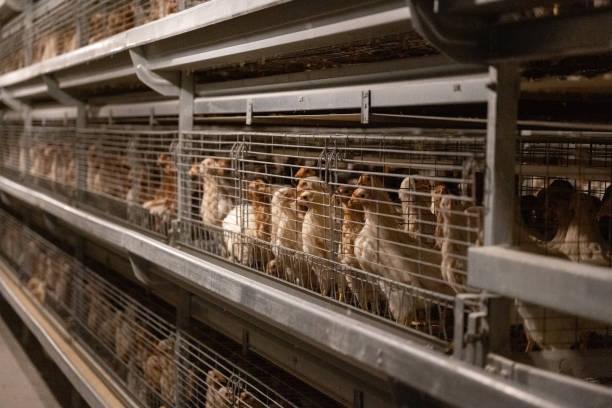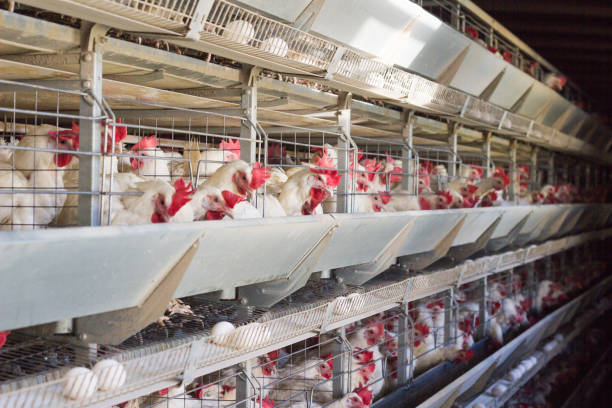
Scaling Up: 90,000 Chicken Cage Solutions for Maximum Egg Production
Scaling Up: 90,000 Chicken Cage Solutions for Maximum Egg Production
For poultry farmers looking to significantly boost their egg production, the prospect of housing 90,000 chickens can be both exciting and daunting. Successfully managing an operation of this scale requires meticulous planning, the right equipment, and a deep understanding of poultry management practices. Choosing the right chicken cage system is crucial. This article will explore the essential considerations for implementing a 90,000-chicken cage solution, focusing on maximizing egg production, animal welfare, and overall efficiency.
Understanding the Scope: Why 90,000?
Before diving into the specifics of cage solutions, let’s address why a farmer might target a 90,000-hen operation. The decision often boils down to economics and market demand. A farm of this size can achieve significant economies of scale, reducing per-egg production costs and increasing profitability. Furthermore, larger operations are better positioned to meet the demands of major retailers, distributors, and food processors.
The Critical Role of Chicken Cages: More Than Just Housing
Chicken cages are not simply boxes to contain birds; they are integral to the health, productivity, and manageability of a large-scale layer operation. The right cage system can optimize space utilization, improve hygiene, reduce disease transmission, and simplify egg collection. Here’s a breakdown of key types and considerations:
Types of Chicken Cages for Layer Hens:
A-Frame Cages: A-frame cages are a traditional and widely used design in poultry farming. These cages are arranged in rows, forming an “A” shape, which allows for efficient use of space and easy access for feeding, watering, and egg collection. The structure typically features tiers of cages stacked vertically, maximizing bird density without compromising welfare.
Advantages:
Excellent ventilation and air circulation contribute to a healthier environment.
Simple design facilitates easy monitoring and maintenance.
Economical and cost-effective, particularly for large-scale operations.
Disadvantages:

Manual egg collection may be labor-intensive for larger operations.
Can be less bird-friendly compared to enriched or aviary systems.
H-Frame Cages: H-frame cages represent a modern and efficient approach to layer hen housing. These cages are structured in an “H” shape, with rows of cages stacked horizontally and vertically. This design maximizes space utilization and streamlines operational processes. H-frame cages are typically equipped with automated systems for feeding, watering, manure removal, and egg collection, significantly reducing labor requirements and improving overall efficiency.
Advantages:
Automated systems for feeding, watering, manure removal, and egg collection, reducing labor costs.
Optimized space utilization with horizontal and vertical stacking.
Improved hygiene and disease control through automated waste management.
Disadvantages:
Higher initial investment compared to A-frame cages.
Complex maintenance requirements due to automated systems.
Enriched Cages: Enriched cages are designed to provide layer hens with a more natural and stimulating environment. These cages incorporate features that enable hens to perform natural behaviors such as perching, scratching, and nesting. Enriched cages typically include perches, scratching areas, and nest boxes, promoting physical activity and psychological well-being.
Advantages:
Improved animal welfare through enhanced living conditions.
Compliance with animal welfare regulations and consumer demands.
Potential for higher egg quality and flock health due to reduced stress.
Disadvantages:
Higher costs associated with larger cage size and additional features.
Density may be limited to ensure adequate space and resources per hen.
Aviary Systems: Aviary systems represent a cage-free alternative to traditional cage setups. These systems allow hens to move freely within a large, enclosed space, promoting natural behaviors and social interactions. Aviaries typically feature multiple tiers, ramps, perches, and nesting areas, providing hens with opportunities for exercise, exploration, and roosting.
Advantages:
Maximum freedom of movement and natural behavior for hens.
Improved bone strength and muscle development due to increased activity.
Consumer appeal due to cage-free production methods.
Disadvantages:
Higher risk of disease transmission and pecking problems in larger flocks.
More complex management requirements for ventilation, lighting, and litter maintenance.
Higher capital investment due to extensive infrastructure and equipment needs.
Key Considerations When Choosing Layer Chicken Cages:
Space per Bird: Providing adequate space per bird is crucial for preventing overcrowding, reducing stress, and ensuring hen welfare. Industry standards and regulations often specify minimum space requirements, so it’s essential to adhere to these guidelines.
Material and Construction: The quality of cage materials and construction directly impacts the durability, longevity, and hygiene of the system. Galvanized steel is a common choice for its corrosion resistance and strength. Choose cages that are easy to clean and disinfect to maintain a sanitary environment and prevent disease outbreaks.
Ventilation: Proper ventilation is essential for maintaining air quality, removing excess moisture, and preventing the buildup of harmful gases such as ammonia. Ensure that the cage design allows for adequate airflow and consider incorporating ventilation systems such as fans and air inlets to regulate temperature and humidity levels.
Feeding and Watering Systems: Efficient feeding and watering systems are essential for ensuring that all hens have access to adequate nutrition and hydration. Automatic feeding systems can deliver feed uniformly and consistently, while nipple drinkers provide a clean and reliable source of water.
Egg Collection: The method of egg collection can significantly impact labor costs and egg quality. Manual egg collection is labor-intensive but may be suitable for smaller operations. Automatic egg collection systems, on the other hand, can streamline the process, reduce egg breakage, and improve overall efficiency.
Manure Management: Proper manure management is crucial for maintaining a clean and sanitary environment, preventing odor issues, and minimizing environmental impact. Consider incorporating manure removal systems such as scrapers or belts to remove waste regularly.
Biosecurity integration: Effective biosecurity measures are crucial for safeguarding your flock from diseases, and should be integrated into the design of your chicken cage system. Choose a system that facilitates easy cleaning and disinfection, reduces contact between birds and manure, and allows for controlled access to the poultry house.
Local Climate: Different climates present their unique challenges to poultry farming. So, select a chicken cage system that addresses issues like ventilation, humidity control, and temperature regulation. For instance, in tropical regions with high humidity, well-ventilated open-house systems may be more suitable to prevent heat stress and maintain a dry environment.
Regulatory Compliance: Get well-versed with local rules and regulations about poultry farming, including standards for animal welfare, environmental protection, and food safety and choose a chicken cage system that complies with all requirements.
Designing Your 90,000-Chicken Cage System: Practical Steps
Scaling up to a 90,000-chicken operation involves more than just buying cages. Here’s a step-by-step approach:
Assess Your Space: Accurately measure the available space in your poultry house(s). This will dictate the type and configuration of cages you can use. Consider ceiling height, door locations, and any obstructions.
Calculate Cage Capacity: Determine how many birds each cage can comfortably and legally house. Use this figure and your total bird count (90,000) to calculate the total number of cages needed. Remember to factor in a small buffer for mortality and unexpected losses.
Choose Cage Configuration: Decide whether you prefer A-frame, H-frame, enriched cages, or an aviary system. Weigh the pros and cons of each option based on your budget, space constraints, labor availability, and ethical considerations.
Plan for Automation: Automate feeding, watering, egg collection, and manure removal to minimize labor costs and improve efficiency.
Optimize Ventilation and Lighting: Design a ventilation system that provides adequate airflow throughout the poultry house, regardless of weather conditions. Install a lighting system that mimics natural daylight patterns to stimulate egg production.
Implement Biosecurity Measures: Establish strict biosecurity protocols to prevent disease outbreaks. This includes controlling access to the poultry house, providing foot baths and hand sanitizers, and implementing a rodent and pest control program.
Consider Manure Management: Develop a comprehensive manure management plan that addresses storage, handling, and disposal. Composting, anaerobic digestion, and land application are common options.
Plan for Expansion: If you anticipate future expansion, choose a cage system that can be easily scaled up.
Seek Expert Advice: Consult with poultry equipment suppliers, veterinarians, and experienced poultry farmers. Their expertise can help you avoid costly mistakes and optimize your operation for success.
Maximizing Egg Production: Beyond the Cages

While the right cage system is essential, it’s only one piece of the puzzle. Maximizing egg production requires a holistic approach to poultry management:
Nutrition: Provide a well-balanced diet that meets the specific nutritional needs of laying hens. Consult with a poultry nutritionist to formulate a feed program that optimizes egg production, shell quality, and hen health.
Health Management: Implement a comprehensive health management program that includes regular vaccinations, parasite control, and disease monitoring. Work with a poultry veterinarian to diagnose and treat any health issues promptly.
Lighting: Maintain a consistent lighting schedule to stimulate egg production. Gradually increase the photoperiod (hours of light per day) as hens reach sexual maturity.
Water Quality: Ensure that hens have access to clean, fresh water at all times. Regularly test water quality and treat any contamination issues promptly.
Temperature Control: Maintain a comfortable temperature range in the poultry house. Hens are most productive when temperatures are between 18°C and 24°C (65°F and 75°F).
Stress Management: Minimize stress factors such as overcrowding, noise, and sudden changes in the environment. Provide hens with opportunities to express their natural behaviors, such as perching and dust bathing.
Record Keeping: Keep accurate records of egg production, feed consumption, mortality, and other key performance indicators. This data will help you identify areas for improvement and optimize your management practices.
Employee Training: Provide thorough training to all employees on proper poultry handling, feeding, watering, and biosecurity procedures.
The Importance of Automation in a Large-Scale Operation
For a 90,000-chicken operation, automation is not just a convenience; it’s a necessity. Automating tasks like feeding, watering, egg collection, and manure removal can significantly reduce labor costs, improve efficiency, and enhance biosecurity.
Potential Challenges and How to Overcome Them
Scaling up to a 90,000-chicken operation presents unique challenges:

High Initial Investment: The cost of cages, equipment, and infrastructure can be substantial. Develop a detailed business plan and explore financing options to secure the necessary capital.
Disease Outbreaks: A large flock is more susceptible to disease outbreaks. Implement strict biosecurity measures and work closely with a poultry veterinarian to prevent and control disease.
Manure Management: Managing the manure produced by 90,000 chickens can be challenging. Invest in efficient manure removal and storage systems and develop a comprehensive manure management plan.
Market Fluctuations: Egg prices can fluctuate significantly, impacting profitability. Develop a marketing strategy that includes diversification, value-added products, and long-term contracts.
Making the Decision: Is a 90,000-Hen Operation Right for You?
Before embarking on a 90,000-chicken venture, carefully consider your resources, expertise, and market conditions. A successful operation requires:
Sufficient Capital: A significant upfront investment is required for cages, equipment, land, and construction.
Poultry Management Skills: Extensive knowledge of poultry husbandry, health management, and biosecurity is essential.
Market Access: Secure contracts with egg buyers or develop a strong marketing strategy to sell your eggs.
Commitment: Running a large-scale poultry operation is a demanding and time-consuming endeavor.
Conclusion: A Path to High-Volume Egg Production
Scaling up to a 90,000-chicken cage solution is a significant undertaking, but it can be a highly profitable venture with careful planning, the right equipment, and sound management practices. By prioritizing animal welfare, biosecurity, and automation, poultry farmers can maximize egg production, minimize costs, and achieve long-term success. The decision to scale up should not be taken lightly, and appropriate research is required to ensure positive outcomes.
